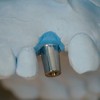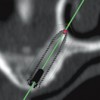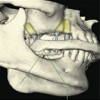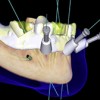Proper boxing of an impression is important to aid in making a quality, durable master cast. It preserves an adequate peripheral roll and provides a protective rim (the land) around the cast. Several methods have been used and this program illustrates several of them including the pumice-plaster method and the beading boxing wax method.
Complete Dentures – Boxing Impressions and Making Casts — Course Transcript
- 1. 8. Boxing Impressions and Making Casts John Beumer III, DDS, MS and Robert Duell, DDS Division of Advanced Prosthodontics, Biomaterials and Hospital Dentistry UCLA School of Dentistry This program of instruction is protected by copyright ©. No portion of this program of instruction may be reproduced, recorded or transferred by any means electronic, digital, photographic, mechanical etc., or by any information storage or retrieval system, without prior permission.
- 2. Procedures Box impressions Pour master casts in stone Trim and index cast
- 3. Boxing Master Impressions and Making Master Casts Purpose – Fabricate a cast that Preserves the peripheral role Provides a protective rim around the cast (land). This rim (land) must be 4-6 mm wide. Produce a dense cast of vacuum mixed stone of the proper dimension (10- 15 mm thick) to permit flasking.
- 4. Boxing the Maxillary Master Impression Two methods Pumice and plaster method Bead and box with wax rods and sheet strips
- 5. Boxing – Beading and Boxing with Wax 1) Apply a layer of sticky wax around the the impression 3 mm below the periphery as shown. Maxillary impression
- 6. Boxing – Beading and Boxing with Wax 2) Apply and seal rods of beading wax to the sticky wax on the impression to form the land.
- 7. Boxing – Beading and Boxing with Wax 3) Wrap a sheet of red boxing wax around the beading wax to form a container. All joints must be sealed with hot wax to prevent stone from leaking through.
- 8. Boxing -Plaster and Pumice Method Draw a line around the impression 3 mm up from the periphery. Set impression in a 1:1 mixture of plaster and pumice. Push impression halfway into the mix. Push the mix up around the impression with a spatula to create a land at the level of the line drawn on the impression. When the mix is set, trim on the model trimmer to create a 4-6 mm land.
- 9. Boxing – Plaster Pumice Method 6) Wrap the impression in sheet wax and seal it to the plaster pumice boxing with hot wax 7) Brush a light layer of vaseline onto the plaster land area so that the stone of the cast does not stick to the land 8) The container made from the wax sheet must be at least one half inch above the highest point of the impression to create an adequate base to the cast.
- 10. Prepare a dense mix of yellow stone using your vacuum mixer and vibrate the stone into the boxed impression. Be careful to avoid entrapment of air bubbles. Pouring the Cast
- 11. Boxing the Mandibular Impression Apply a layer of rubber base adhesive or hot sticky wax to the impression as shown. This layer should about 3 mm above the height of the border of the impression .
- 12. Boxing the Impression Apply a strip of red beading wax to the sticky wax layer to form the land of the cast. Close the lingual tongue area of the impression with a sheet of wax or with pumice and plaster.
- 13. Boxing the Impression Wrap a layer of boxing wax around the impression to form a wax container. All joints must be sealed to prevent seepage of stone into undesirable areas
- 14. The same result can be achieved by boxing the entire impression with a mixture of plaster and pumice (to form the land area) and boxing wax to create the enclosure. If you use this method be sure to coat the plaster pumice mixture with vaseline before you pour stone into impression so that cast will separate from this mixture. Boxing the Impression
- 15. Pouring the Cast Vacuum mix the yellow stone Carefully vibrate the stone into the impression. Start on the buccal of one side and progress to other side. Before you pour the cast make sure the boxing is sufficient to permit the fabrication of a cast at least 10 mm thick .
- 16. Remove the Cast from the Impression : Wait 1 hour for the stone to set Immerse the cast-impression into hot water for 5 minutes to soften the compound border molding before separating the cast from the impression.
- 17. After heating the compound in a water bath, carefully separate the cast from the impression Retrieving the Cast
- 18. With a model trimmer flatten the base so that the base is parallel to the ridge. The cast should be ½ inch thick. Trim the sides of the cast so that there is an even 4-6 mm of land around the cast. Trim the land with a burr or sharp knife and reduce so that the depth of the peripheral roll is 2-3 mm throughout. Trimming the Cast
- 19. Trim master casts. The base should be no thicker than 15-20 mm. If the base is too thick the cast will not fit within the confines of the denture flask. The land of the cast must be at the same level as the edge of the lower member of the flask. Trimming the Master Cast
- 20. Completed Master Cast Land (4-6mm thick) Base (15-20 mm thick) Depth of peripheral roll (2-3 mm)
- 21. The base for this cast was insufficient and eventually it fractured necessitating remaking of the impression Trimming the Master Cast
- 22. Master Casts These casts have been properly trimmed and marked. Place rounded notches (arrows) on the bottom of the master cast. These notches will later be used to remount the processed denture back onto the articulator. The notches should be placed on the back and on the sides of the casts.
- 23. Anterior land Cast Landmarks – Maxilla Midline Incisive papilla
- 24. Lines indicating the crest of the ridge Cast Landmarks -Mandible Midpoint of retromolar pad Land Mark on land indicating the midpoint of the retromolar pad


 Cement Retention vs Screw Retention
Cement Retention vs Screw Retention
 Prosthodontic Procedures and Complications
Prosthodontic Procedures and Complications
 Angled Implants
Angled Implants
 Computer Guided Treatment Planning and Surgery
Computer Guided Treatment Planning and Surgery
